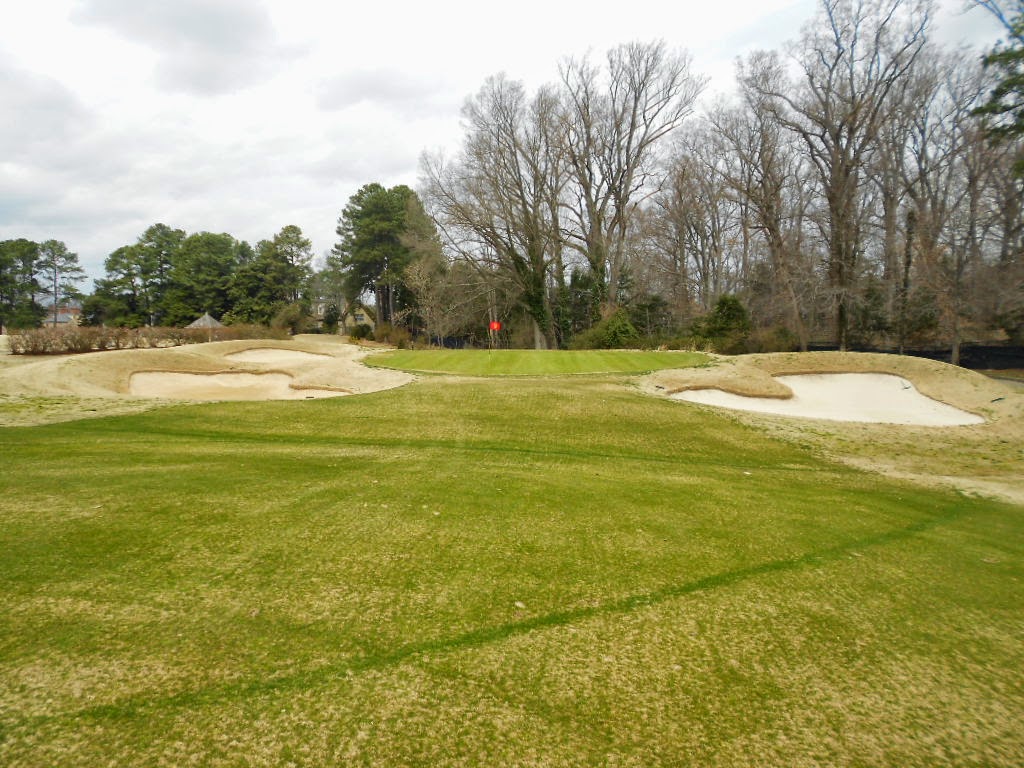March 17, 2014
I played
Shadow Creek Golf Club earlier today and the prevailing thought that has dominated my mind over the last few hours since finishing is wow!
As I wore my new Shadow Creek logo polo to lunch after arriving back at my hotel, I was asked half a dozen times if the cost was worth it. The short answer is most definitely. After all, it has two of the 500 greatest holes in the world as listed in
The World's 500 Greatest Golf Holes (#17 and #18).
For those that aren't aware, the green fee is a flat $500. The caddie fee is anywhere from $50 to whatever you think the caddie has earned. A new logo shirt is $100. A logo ball is $5. That is a tremendous amount of money for one round of golf. My answer is still most definitely. Oh, and lest I forget to mention, you have to be a guest at an MGM resort property to even be considered for a tee time. Even the U.S. President and the Canadian Prime Minister were denied a tee time because they were not guests at an MGM Resort Property according to
this news article in the
Las Vegas Sun newspaper.
You don't drive to Shadow Creek. The front gate won't let you enter. You are picked up at the lobby of your hotel by a stretch limousine and transported north of the city to the golf course.
The course is surrounded by a big black wrought iron fence in a 360 acre area. The drive from the gate to the clubhouse is a few miles. Along the way, you see one of the two residences located on the property. The drive really sets the tone for what you are about to experience. Trees line the road and the gaps between the trees are filled with lush green grass. At the end of the drive is the clubhouse, a simple, green and white building. There is nothing that screams glitz or glamour like what you find back on the strip. But, attention to detail stands out as you stroll through the clubhouse to let you know you are in for a treat.
 |
| The Shadow Creek Golf Course Club House |
Once the limo pulls to a stop, you are greeted by two or three staff members and your assigned caddie. One staff member takes care of your clubs. Another staff member gives you a tour of the facility. My caddie, Scott, who was fantastic the entire day, asked if I needed anything and advised he would meet me on the practice range. After the tour of the clubhouse, I was led to the gentlemen's locker room. It is the single largest golf locker room I have ever been inside.
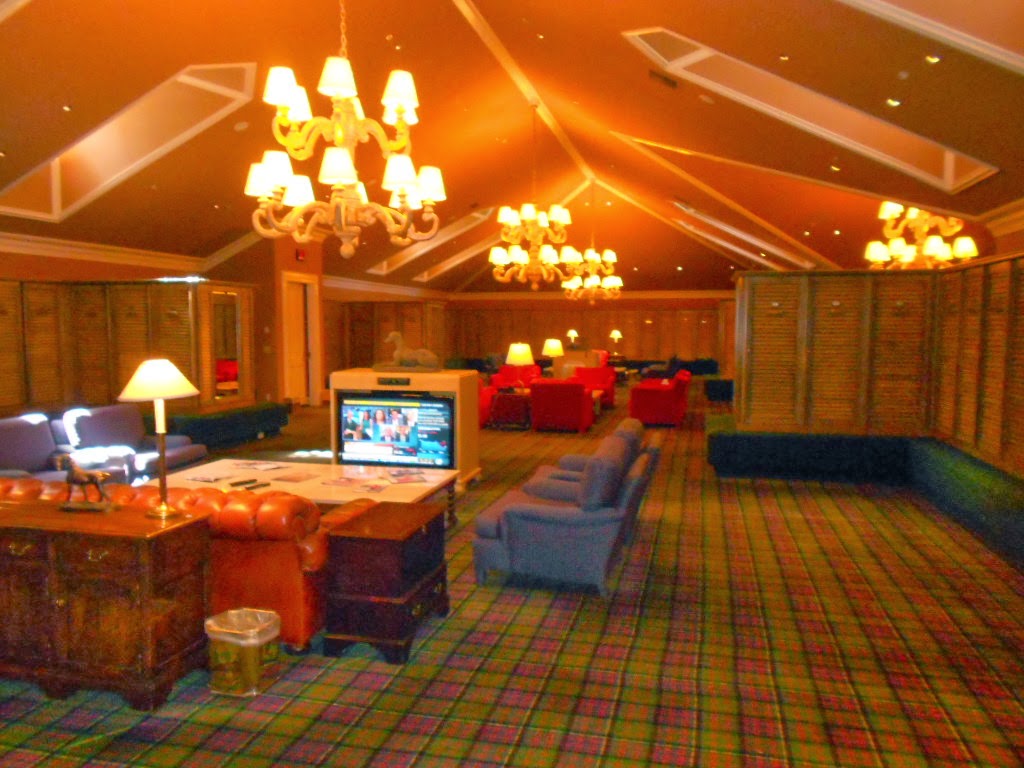 |
| A look from the front right corner of the locker room. |
The lockers are hardwood and have famous names on them, from former presidents, to famous athletes, to business leaders across the world.
 |
| A closer view of the back half of the locker room. |
While changing into my golf shoes, I was advised to feel free to take my time with a stroll through the clubhouse at my leisure since they don't really observe tee times. I obtained permission to take photos on the course before leaving the locker room. I made my way to the pro shop where I paid my green fee, as well as purchased a new Shadow Creek logo golf shirt and logo golf ball for my cabinet. Once I had finished spending a paycheck worth of cash, I headed out to the practice facility.
One note to remember while reading this blog. Keep reminding yourself that each photo is taking at a golf course located in the middle of a desert. It shows what enough money and determination can build. It is reported to have cost more than $60 million to build. There are more than 200 types of trees spread throughout the course. There is also numerous forms of wildlife found throughout, including the ever-present pheasants. The course features rolling terrain, valleys, creeks, trees, and gulches, as well as any other topographical feature you can imagine, and all of them were sculpted from the once flat desert wasteland. I have read if you were blindfolded and a helicopter dropped you off here, that once you removed the blindfold, you would think you were in the Carolinas or Georgia. It is absolutely a true statement. The only sand I saw on the entire course was in the sand traps. There was no desert seen anywhere on the course. All distances noted below are from the regular tees. The back tees and championship tees are a good distance further than what is listed in the below notes and photos.
The day was perfect for golf. It was 55 degrees at the start of the day, rising to around 70 by the end of the round. There was a light breeze throughout the day to keep it pleasant. And, the sky was clear blue with only a few clouds scattered about. The greens were firm, but fair, throughout the day. A few greens ran quick, but it was nothing like my round at
Cascata GC yesterday, where the ball would rocket off the green.
 |
| A look down the fairway from the #1 tee box. |
The first hole is a 344 yard, par 4. It turns towards the left but isn't a true dogleg, though the green is hard to see from the tee box. You want to hit your drive to the left center and allow the land to carry the ball back to the center.
On the approach shot to the green, you want to stay left. The rolling fairway runs down into the creek on the right. The green undulates a bit, but nothing that can't be read with the help of your caddie.
 |
| A look in the the 1st green from 130 yards out. |
The second hole is a par 4 that plays 381 yards. After carrying the valley on your drive, the fairway gradually slopes to the right.
 |
| A look down the fairway from the #2 tee box. |
Once you make your way down the fairway, the green comes into view. The first thing that is immediately noticeable is the three large bunkers that guard the land around the green. These greens can be very steep at certain places and it is best to follow my daughter's advice - Do not, do not, do not go into the sand.
 |
| A look into the #2 green from 150 yards out. |
As I have started doing a good bit when I play a new course, I look back down the fairway from the green to get a better idea of what the course architect was looking at when designing the course. On this particular hole, it struck me that from the tee box, and even from the center of the fairway, you can not really see how steep the slope of the fairway is when you get closer to the green. I tried to catch the grade in the photo below.
 |
| A look back down the #2 fairway from behind the #2 green. |
Hole #3 is the third consecutive par 4, playing a long 449 yards. The fairway slopes precariously left towards the lake on the left side. Much like the first hole, you want to hit your drive to the high side of the fairway and let the hill roll your ball back to center.
 |
| A look down the fairway from the #3 tee box. |
Once you get down near the left side sand traps, the green comes into view. A small hill on the right side can make for a tricky approach shot depending on where the pin is placed.
 |
| A look into the #3 green from 180 yards out. |
The 4th hole is the first par 5 on the course, playing at 512 yards. It is a horseshoe shaped fairway that follows the edge of a large lake. It is surreal that a weeping willow dominates the center of sight at a course located in the desert.
 |
| A look down the fairway from the #5 tee box. |
As you move down the cart path, the green comes into view, giving you a sneak peak of what to expect in a few, upcoming shots.
 |
| The #4 green can be seen across the lake. |
Once you get around the bend of the fairway, a straight on look into the green opens up. It is a risk-reward hole, as you can choose to hit straight across the water that is right next to the green, or you can go right of the green and play it safe.
 |
| A look into the #4 green from 130 yards out. |
The back of the #4 green is guarded on both sides by large bunkers. Like quite a few greens at Shadow Creek, this one is a multi-tiered green, and an errant shot can send the ball rolling off the green and towards the numerous hazards around it.
 |
| A look into the #4 green from 70 yards out. |
Hole #5 is the first par 3 of the course and plays 140 yards long. You are also treated to this same view as you are taking the initial drive to the clubhouse from the gate. The layout of the hole is reminiscent to Augusta or Pine Valley and is a gorgeous hole. You want to stay to the left center of the green, but not the left edge. The left edge is going to have your ball run all the way down into the valley. The right side of the green has a slight slope, but your ball will pick up speed and quickly exit that side of the green if you start out left of the pin.
 |
| A look into #5 green from the tee box. |
Hole #6 is a Par 5 that plays 442 yards long. It is a slight dogleg right and the play is to the left center of the fairway to afford a straight in look to the green.
 |
| A look down the fairway from the #6 tee box. |
Once at the turn in the dogleg, you get a terrific view of the green. The fairway slopes down towards the green. There are large bunkers along the right side to be aware of.
 |
| A look into the #6 green from 200 yards out. |
Hole #7 is a 490 yard, par 5. The drive should be to the right center so the ball can roll down and to the left towards the green.
 |
| A look down the fairway from the #7 tee box. |
After clearing the hill, you are left with a fairway that initially slopes from right to left before leveling off. A large bunker on the right may catch your ball driven to the right center, but it is still probably a better option than hitting your second shot from the trees on the left.
 |
| A look down the #7 fairway at the top of the hill affords a great view into the green. |
The front of the #7 green is guarded by four sand traps. The shot to the right side of the green should roll back left as the slope of the green will take the ball that way most of the time.
 |
| A look into #7 green from 50 yards. |
Looking back down the #7 fairway is an incredible view, not only of the golf hole, but of the mountains in the distance.
Mount Charleston Alpine Resort Golf Club was a 9 hole course that was located on that snow-capped mountain on the left. It went out of business several years ago, but my caddie assures me the views were fantastic.
 |
| A look back down the #7 fairway from the #7 green. |
Hole #8 is the second par 3 on the course, playing 162 yards. The elevation of the tee box is higher than the green, allowing you to go a club shorter. The green slopes down and to the right, so if you don't hit just the right shot, you will likely find yourself below the green, in either the rough or the sand trap.
 |
| A look into the #8 green from the tee box. |
The 9th hole is a 391 yard, par 4. The water follows the left side of the fairway all the way to the green. The drive should stay to the right side of the fairway, keeping you well clear of the water and giving a good look at the second shot.
 |
| A look down the fairway from the #9 tee box. |
After passing the right side fairway bunkers, you see where the creek winds its way towards the center of the green before flowing back left.
 |
| A look into the 9th green from 200 yards out. |
If you didn't stay on the right side of the fairway, the shot into the green will be challenging, as you have to play up a slight hill and over sand. There is an opportunity that you can hit to the hill on the right of the green and the slope will carry your ball back towards the flag.
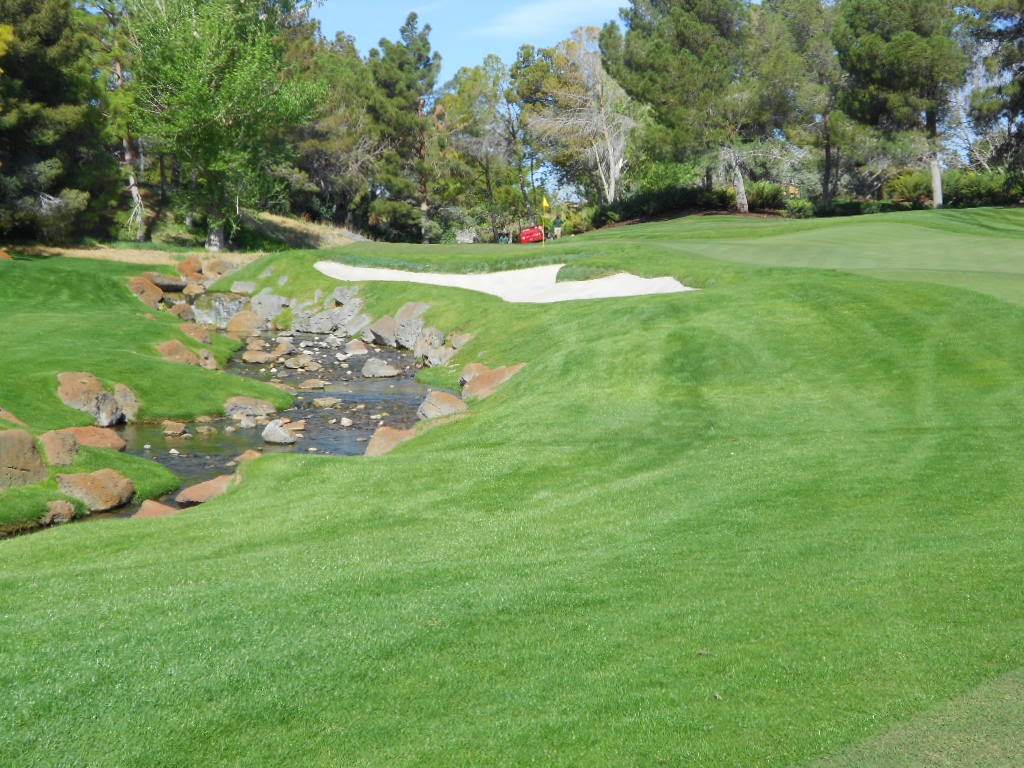 |
| A look into the 9th green from 60 yards out. |
The back 9 starts off the same as the front, with three consecutive par 4s. Hole 10 plays 394 yards. It is a dogleg right. If you hit the drive over the right side bunker, your view into the green will be obstructed by a large tree. The play is definitely to the left side of the fairway.
 |
| A look down the fairway from the #10 tee box. |
Once you make the turn at the dogleg, the green comes into view. As mentioned above, if your drive went right, you are going to have a difficult shot to get over the tree and onto the green. Even from the left side, only half of the green is visible. On this day, the flag could barely be seen on the left edge of the large tree.
 |
| A look into the 10th green from 150 yards out. |
The 11th hole is a par 4 that plays 284 yards. It is a very short par 4 that awards a long hitter. However, you should remember that this green is fairly quick and the chance of holding the green with a driver is almost nil.
 |
| A look down the fairway from the 11th tee box. |
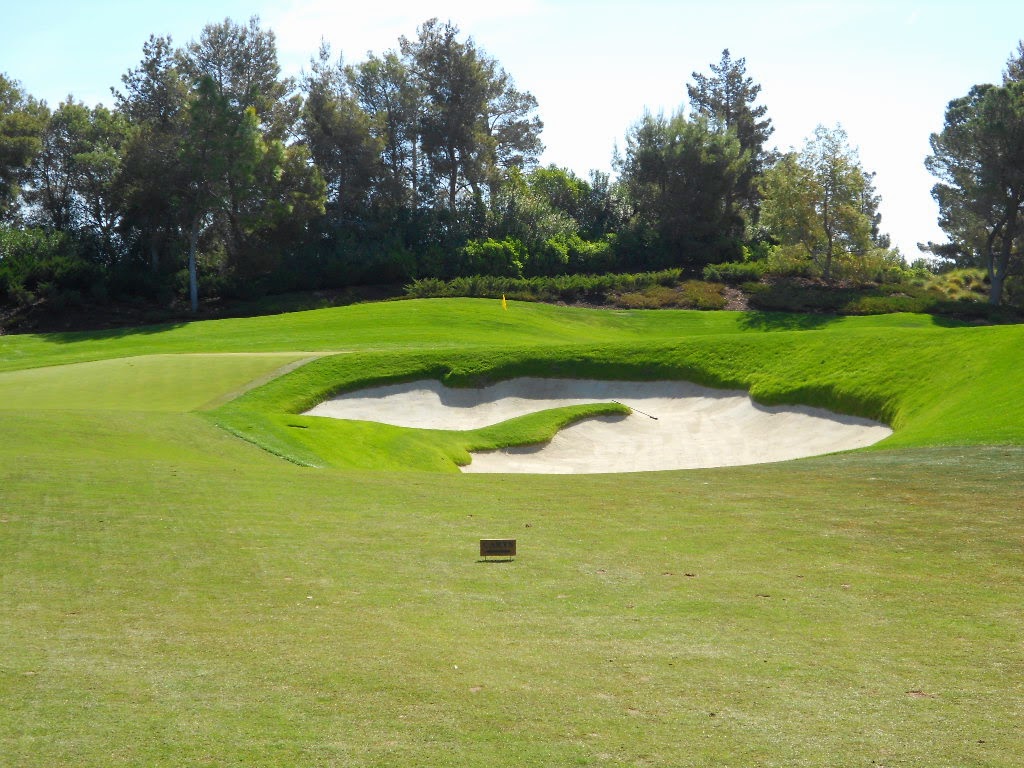 |
| A closer look into the 11th green from just below the bunker. |
The 12th hole is a 355 yard, par 4. It is a fairly straight, uphill fairway. A shot to the left or right can lead to trouble so center is definitely your best option here.
 |
| A look down the fairway from the 12th tee box. |
The majority of the green is tucked in behind the right side bunkers. The hill on the right slopes back down into the green from right to left, allowing the ball to roll back towards the hole.
 |
| A look into the 12th green from 130 yards out. |
The 13th hole is the first par 3 on the back 9, playing from a long 203 yards at the regulation tees, and a mammoth 257 yards from the tips. The front left of the green slopes sharply downhill and you can easily find a short shot back in the rough. If the ball leaks too far right, you could find it rolling off the green and towards water.
 |
| A look into the green from the 13th tee box. |
The 14th hole is a 442 yard, par 4. It is a dogleg right. A ball hit to the left side of the fairway will haev the slope leading the ball right and into the center of the fairway for your second shot.
 |
| A look down the fairway from the 14th tee box. |
After clearing the dogleg, the green comes into view. A large lake is found on the right and a group of trees to the left. The fairway rolls downhill towards the green, helping reach the long par 4 with a GIR.
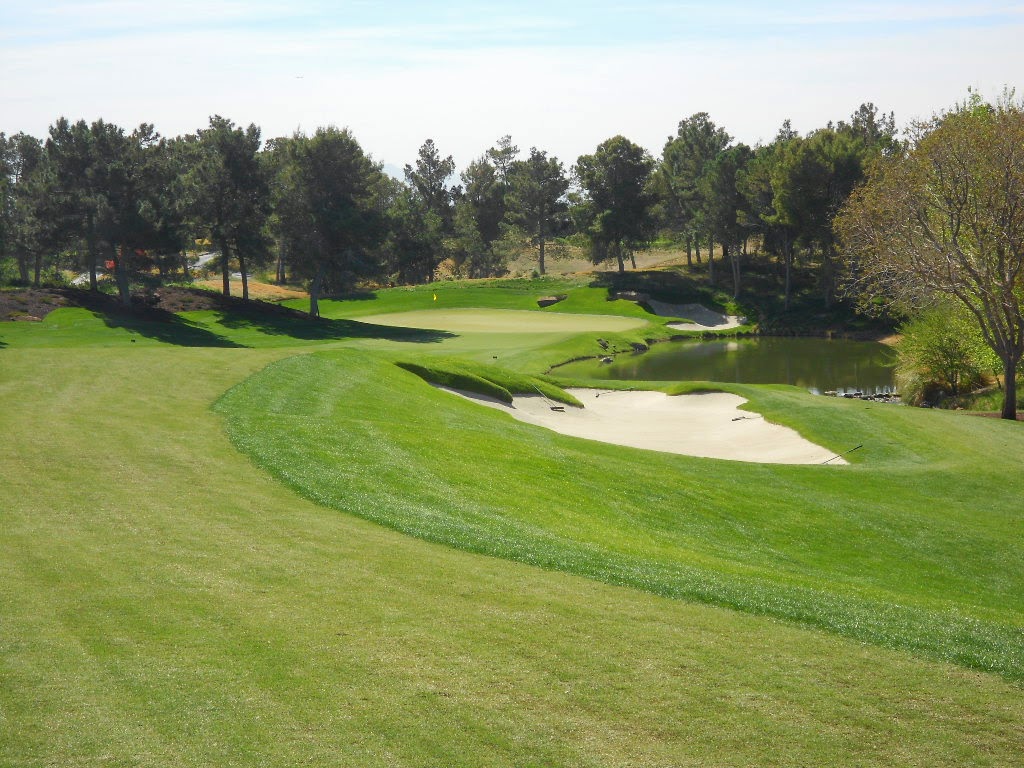 |
| Looking down towards the 14th green from the turn of the dogleg. |
A view into the green shows it slopes very slightly away from the lake, creating a chance to really go for a shot straight at the flag.
 |
| A look into the 14th green from 160 yards out. |
The 15th hole is a 433 yard, par 4. From the tee box, it looks like the fairway initially slopes right to left and then levels out. However, as you get further down the fairway, you see that it continues increasing its slope from right to left all the way to the green.
 |
| A look down the fairway from the 15th tee box. |
Your first view of the green is from around 200 yards out. You also get your first view of the creek that cuts across the fairway in front of the green.
 |
| A look into the 15th green from 200 yards out. |
 |
| A look into the 15th green from 150 yards out. |
As you get closer to the green, more of the creek and rocks come into view. The green also slopes right to the left, creating a difficult approach shot. The creek that flows beside the green and fairway create a very peaceful, bubbling sound that makes one want to take a nap next to it.
 |
| A look back down the 15th fairway from behind the 15th green. |
The 16th hole is the longest on the course, playing 561 yards from the regulation tees and 622 yards from the tips. The fairway creates a S-shape to follow, first turning right and then back left towards the green.
 |
| A look down the fairway from the 16th tee box. |
Once you reach the top of the hill, you can see where the fairway moves downhill and turns back left.
 |
| A look from the center of the 16th fairway towards the green. |
Once you navigate the two turns of the fairway, you find and undulating green guarded on the right by steep bunkers. If you find yourself in one of them, a par or better is going to be a difficult mark to achieve.
 |
| A look into the green from 30 yards out. |
A look back down the 16th fairway shows the beauty of Shadow Creek and prepares you for the signature hole you are about to experience at 17.
 |
| A look back down the 16th fairway from the 16th green. |
The 17th hole is the signature hole of Shadow Creek and is listed in
The World's 500 Greatest Golf Holes. It is a par 3 that plays 140 yards, and has three different vantages points depending on which tee boxes are being utilized. A waterfall flows on the back left side of the green, creating a stunning golf hole. The green is guarded by three bunkers to round out the difficulty of the shot.
 |
| A look into the green from the 17th tee box. |
The 18th hole is a par 5 that plays 503 yards. Like the 17th, this hole is also listed in the
The World's 500 Greatest Golf Holes. I believe they made the last hole a par 5 because most people don't want to leave and want to have a long hole to finish the round and prolong the inevitable departure of Shadow Creek. The drive to the left side of the fairway keeps you clear of several bunkers and a larger body of water.
 |
| A look down the fairway from the 18th tee box. |
Once around the water and over the hill, the green comes into view. It is guarded on the front and right by a lake. To the right of the lake (not pictured) is Steve Wynn's old house.
 |
| A look into the 18th green from 150 yards out. |
 |
| A look into the 18th green from 80 yards out. |
Overall, the Shadow Creek experience was tremendous. It made traveling to Las Vegas worth it. Is it a large amount of money to spend on a round of golf? Sure it is. But, the course, the staff, and my awesome caddie, Scott, helped to create an awesome golfing memory that will last a lifetime. For that kind of memory, it is hard to say there is a price too high.
I look forward to the next time I can schedule a tee time at Shadow Creek. I definitely plan to play it again.
























